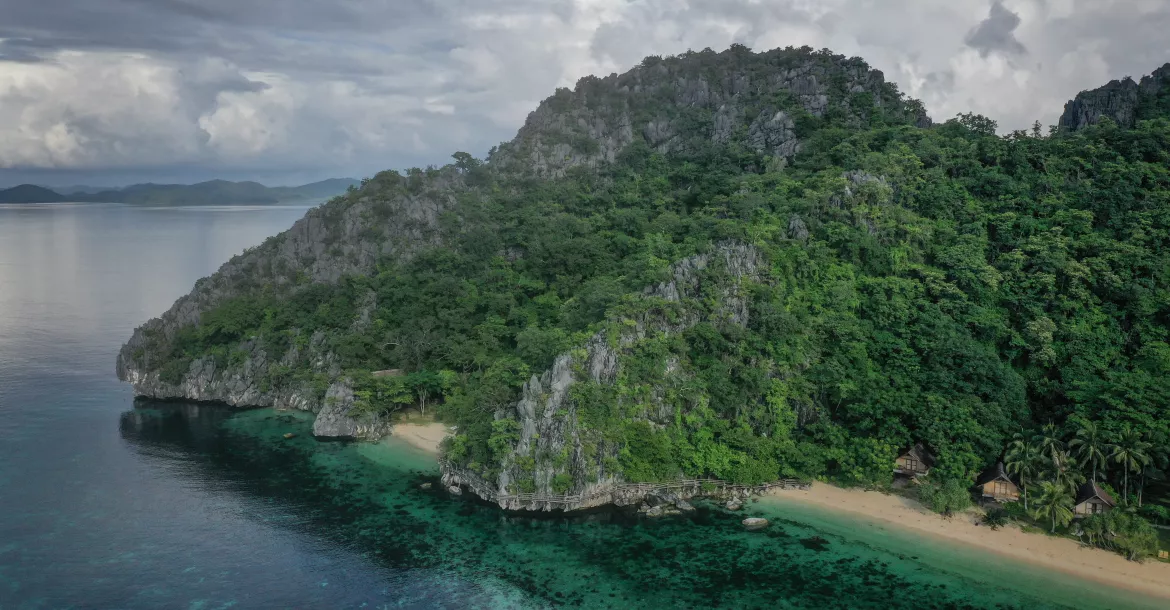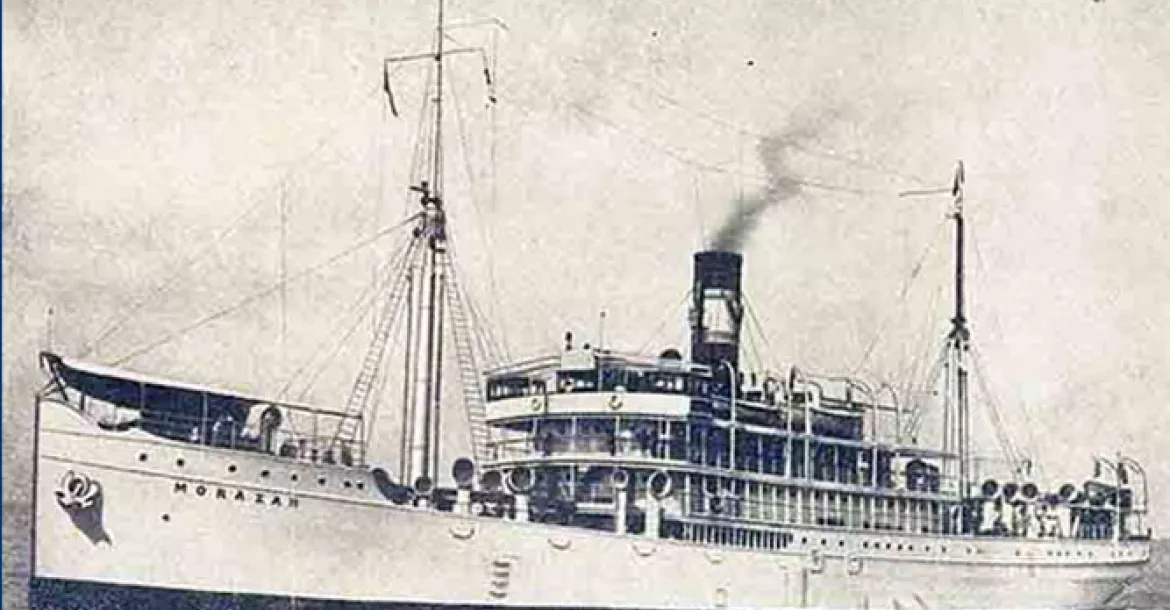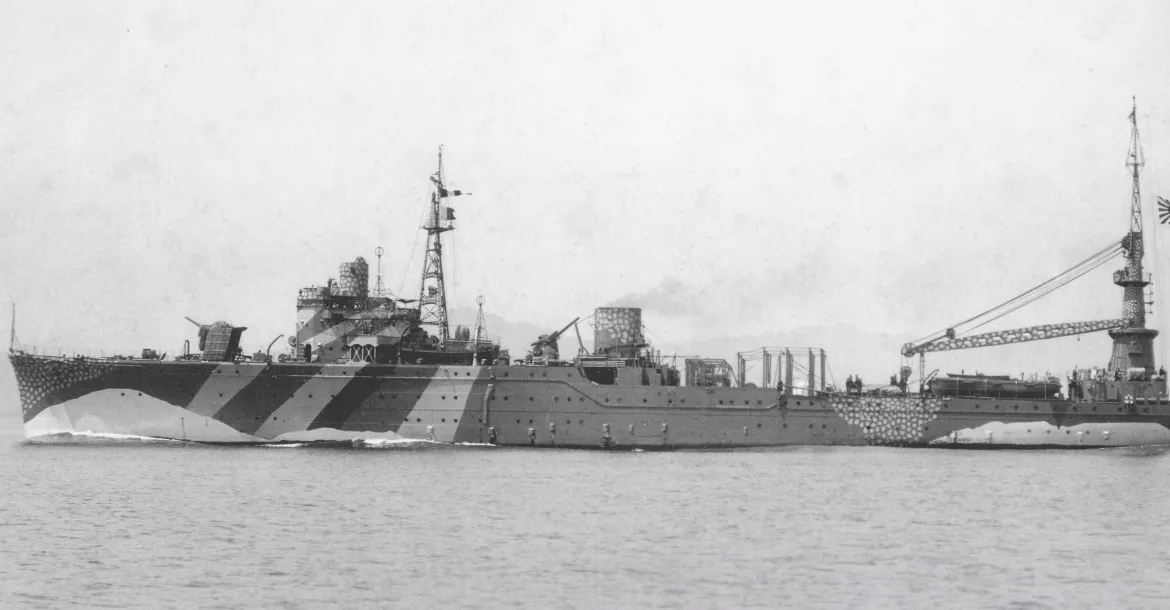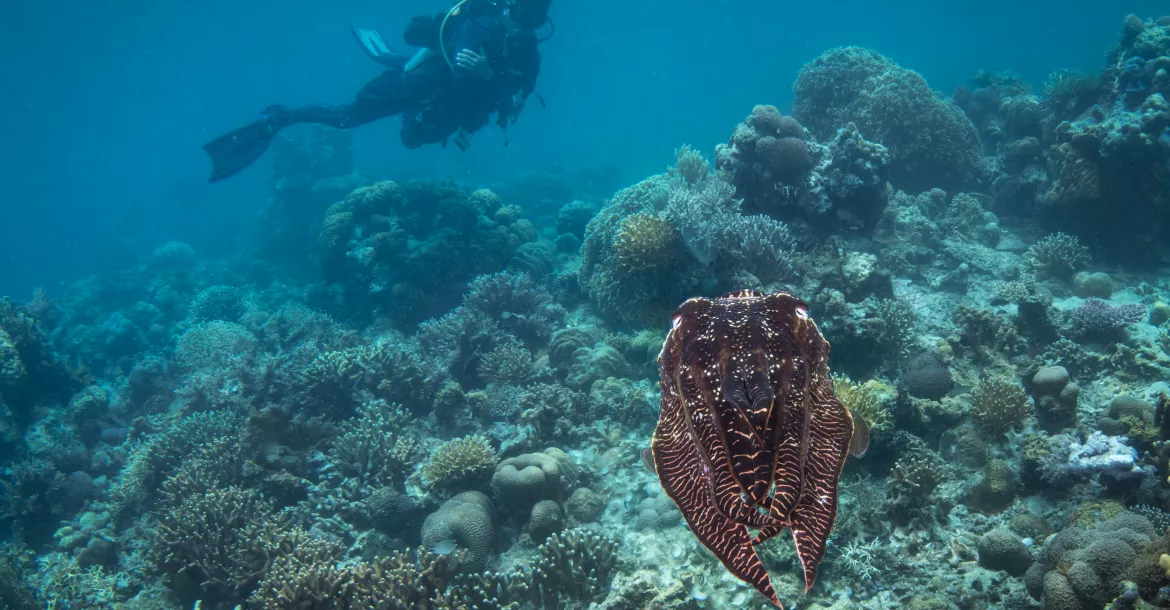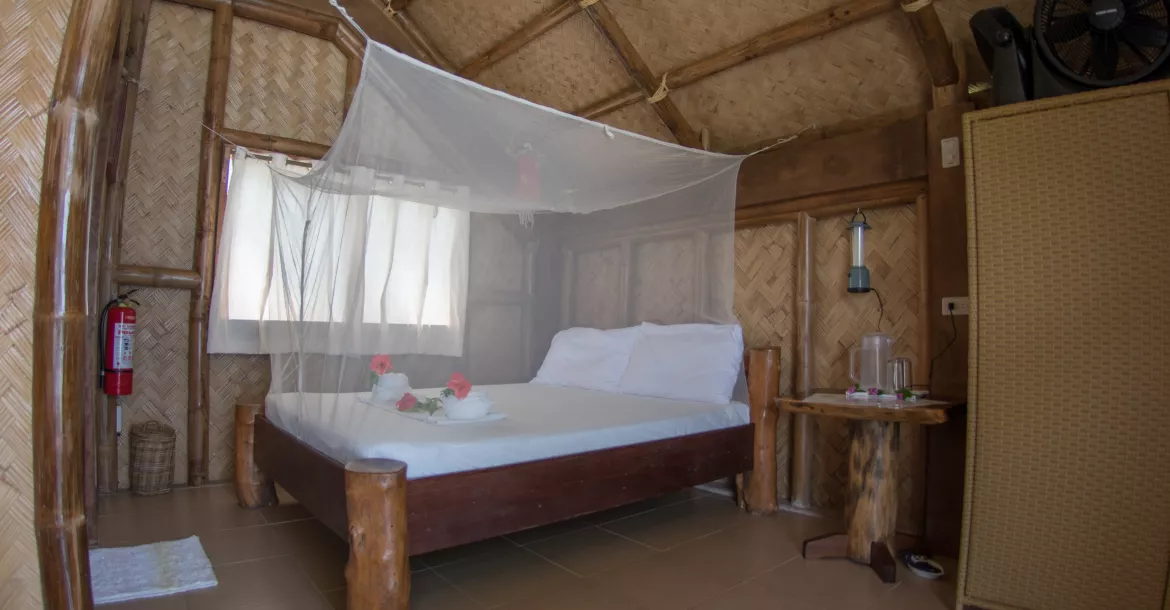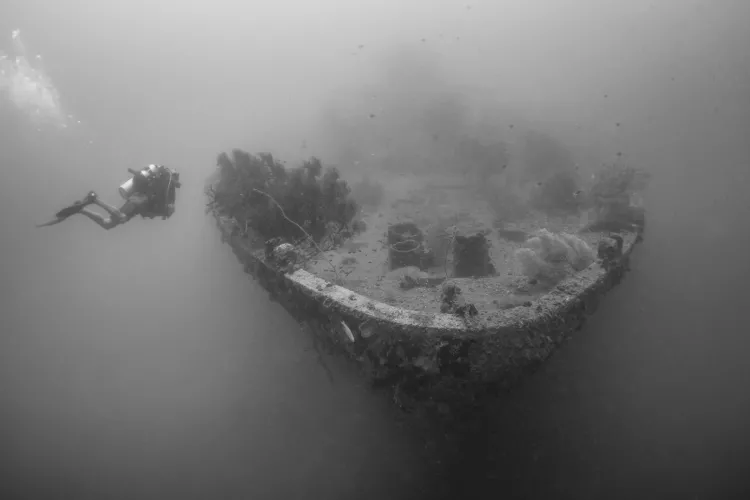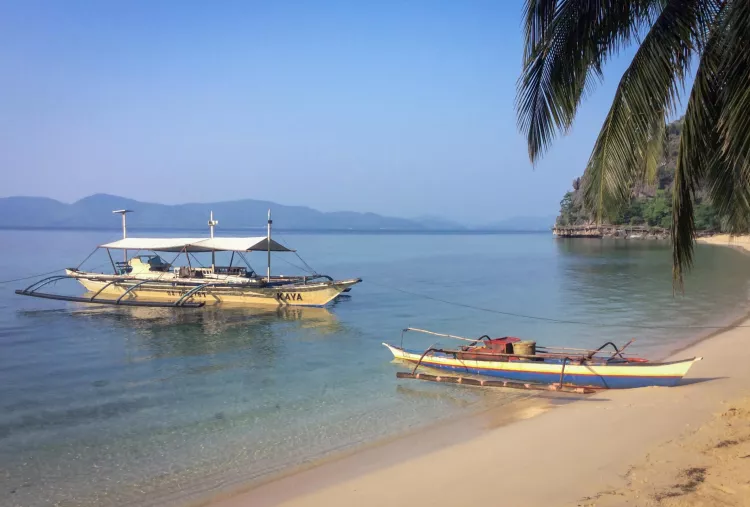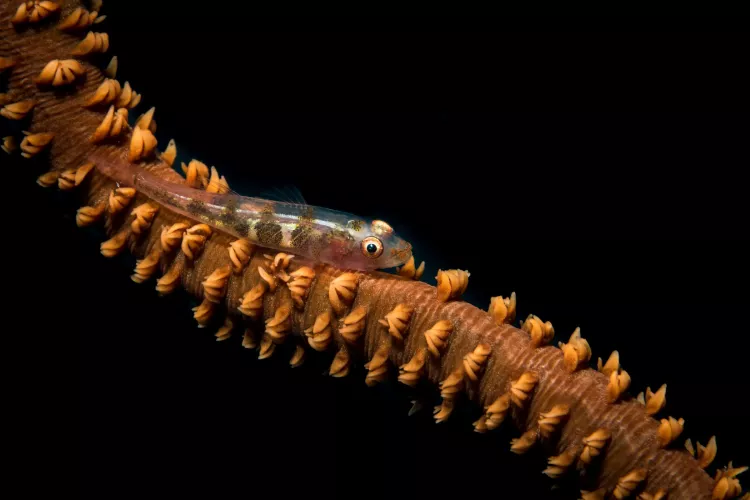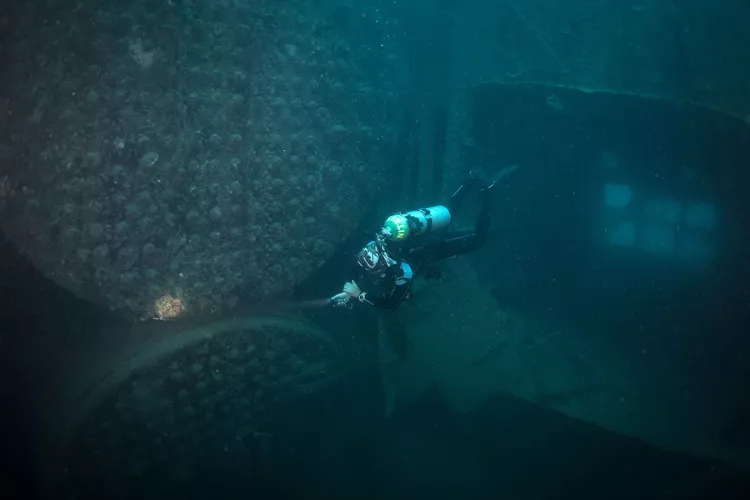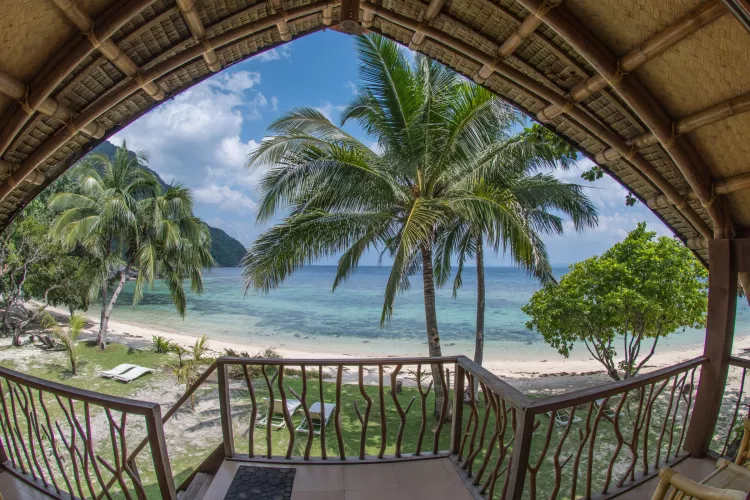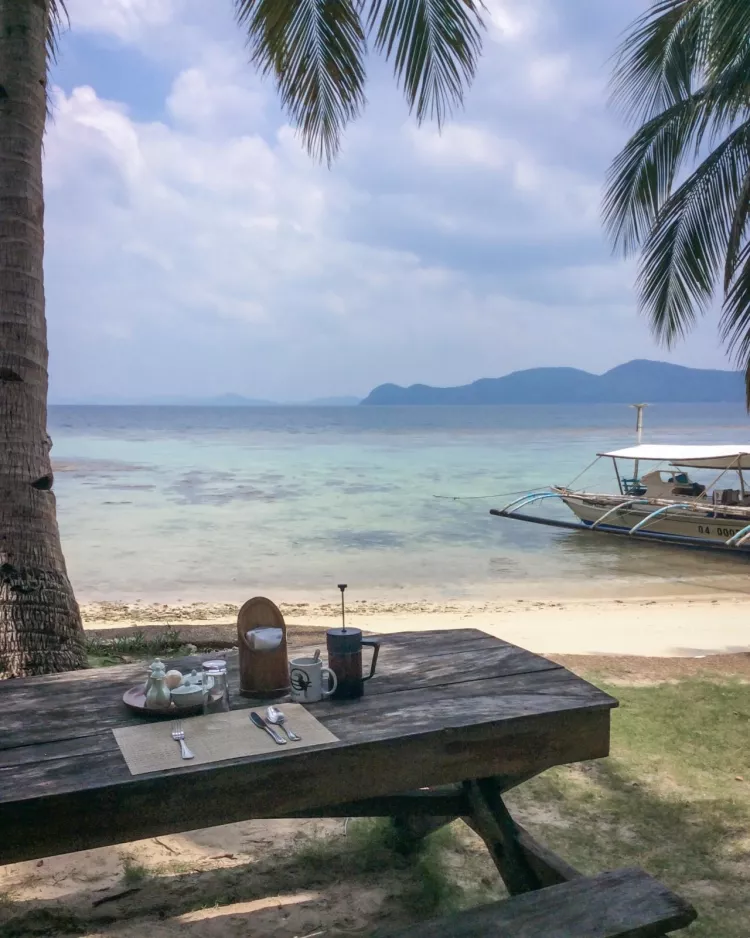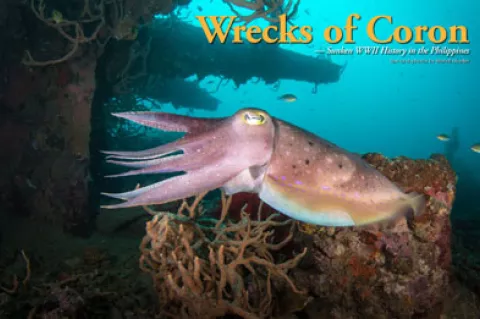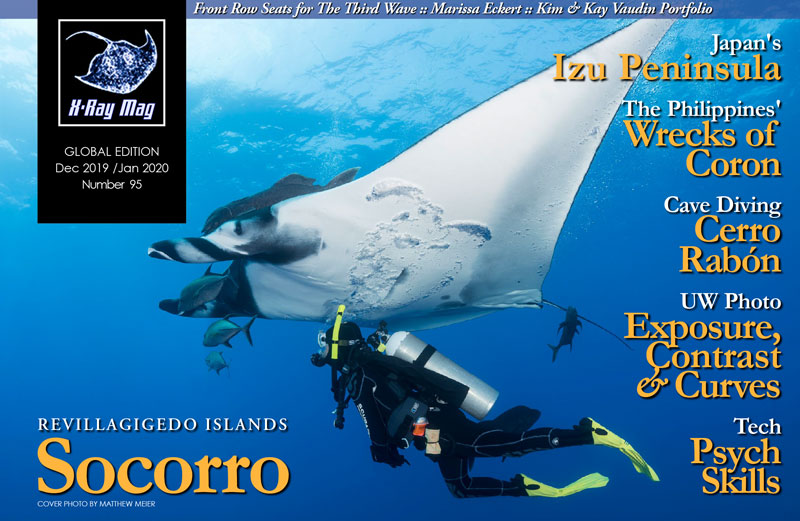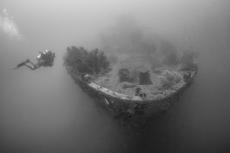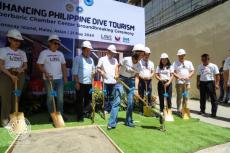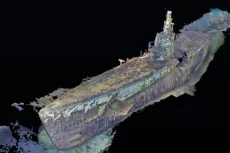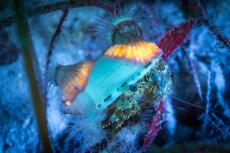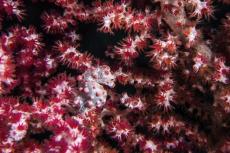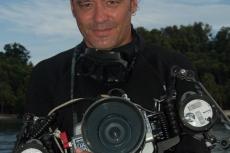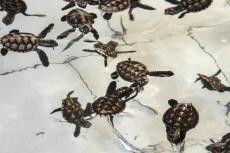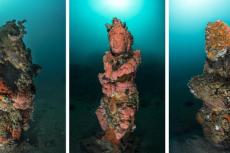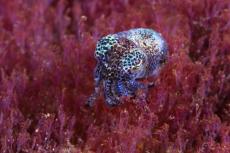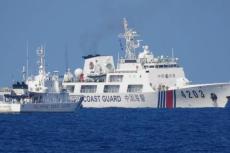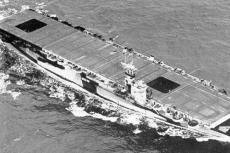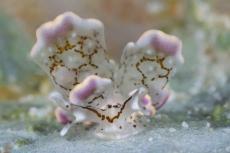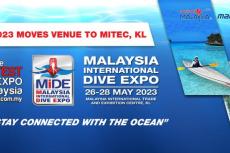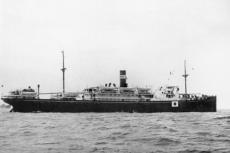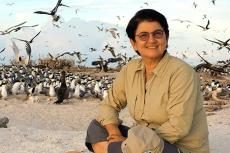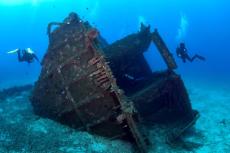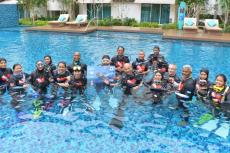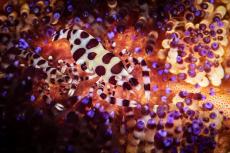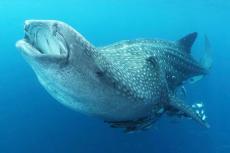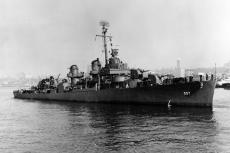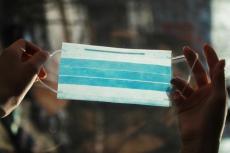Being an avid wreck diver, Coron in the Philippines has been on my bucket list for ages. Having followed the underwater remains of the Pacific Theater World War II battles, I have found myself in some of the most beautiful places on earth, from the Solomon Islands to Truk Lagoon and many others. Coron is no exception. Arriving on the island of Busuanga after a short, one-hour flight from Manila, I was picked up and escorted by van and boat to Sangat Island. As we departed the dock, there were dense mangroves on either side, green foliage encroaching on the small waterway, hardly big enough for two boats to pass in some areas.
Contributed by
Factfile
American underwater photographer, dive writer and regular contributor Brandi Mueller is a PADI IDC Staff Instructor and boat captain living in Micronesia.
When she is not teaching scuba or driving boats, she is most happy traveling and being underwater with a camera.
Mueller's book, Airplane Graveyard, featuring her underwater photos of forgotten American WWII airplanes at the bottom of the Kwajalein Atoll lagoon, is available at: Amazon.com.
For more information, visit: Brandiunderwater.com.
Admiring my surroundings, I lost my breath for a moment when the walls of mangroves on either side seemed to open like a curtain to reveal a wide-open expanse of blue water and many green islands rising up from the water at different heights as far as I could see. “Beautiful” seemed like an understatement.
The boat driver picked up speed as we made our way closer to the dive resort, the only property on the island, where I would be staying to dive the wrecks for the next week. Sheer limestone cliffs got closer and the boat turned a corner past a rock face revealing a white sandy beach and several thatch chalets on stilts. I was soon being shown to one of the chalets with an epic view of palm trees and ocean in front of me, and even macaque monkeys could be seen wandering the grounds.
WWII, Coron, 1944
In the summer of 1944, the Americans and Allied forces ramped up action in the Philippines. From September 21 to 24, the United States attacked Manila Bay, sinking 15 ships. In an effort to protect the rest of the fleet, the Japanese sent the remaining ships to locations they had hoped were safe and out of range. Several ships made their way to Coron Bay to essentially hide out and hopefully not be found by the Americans.
It is unknown if the ships were discovered by aerial photo reconnaissance or if Japanese radio transmissions were intercepted, but their location was no longer a secret. The US carrier group was 340 miles from Coron Bay, but Admiral William F. “Bull” Halsey from the battleship USS New Jersey designed a mission that was approved by Vice Admiral Marc A. Mitscher, commander of Task Force 38 on the aircraft carrier USS Lexington.
Ninety-six Grumman F6F Hellcat fighters and 24 Curtiss SB2C Helldiver dive bombers took off at 5:50 a.m. on September 24 for what was the longest-range air attack ever launched from aircraft carriers at that time. They arrived at 9:00 a.m., and in just minutes, they took out the fleet and quickly departed so they could make it back safely. As they flew back to the carriers, there were 12 ships sunk or burning in the bay behind them. The planes all returned safely. One ship was reported to have escaped, the Kamoi, damaged, but later reported to have made it to port in Hong Kong.
Underwater for 75 years, these ships now rest below the waves of one of the most beautiful places in the world, both on land and underwater. Topside sheer limestone cliffs and rock faces jut out of the blue waters and are covered in flourishing jungle. Located within the Coral Triangle, the oceanic region with the highest marine biodiversity on Earth, the ships are covered in abundant and colorful marine life. Unfortunately, the ships have been extensively salvaged, with their propellers, engines and artifacts removed, but there is still plenty left to see on the ships.
Olympia Maru
My first dive was on the Olympia Maru, a 400ft (122m) freighter sitting upright with the top deck around 60ft (18m). I was visiting during the rainy season when visibility can be a bit murky, and we descended for a few minutes before the shadow of a ship came into view. Starting at the stern, I followed my dive guide straight into the sterncastle of the ship. Coils of lines could be seen, and a stash of beer bottles were on the floor, but what I mostly noticed were several ladders and support beams bending at the weight of the ship. As the years pass, and time and the ocean take their toll on these ships, it is important to remember that they are ever changing. I was told some of the decks were starting to pancake on top of one another, and what I saw concurred with this warning.
We continued swimming through the interior of the ship—in and out of massive cargo holds with blue ambient light streaming in. A large boiler remained as well as many crushed fuel drums. Even inside the dark and rusty wreck, there were schools of cardinalfish and other small silvery fish, which reflected like glitter in our dive lights.
Emerging from within the bowels of the ship, I was greeted at the bow by sunlight and fish everywhere. A huge school of yellow goatfish stretched from one side of the ship to the other and fusiliers darted around feeding in the water column behind them. The gun turret remains but there is no gun. Inspecting the platform, there was a giant cuttlefish doing a poor job of hiding underneath. Its brilliant purple and maroon colors gave it away in an instant and it flashed bright colors for my camera.
Shallow depths allowed for a nice long dive on 32 percent nitrox, and we slowly made our way back to the stern on the outside of the ship, which was teeming with fish. I returned to the surface after the first dive, excited for more.
Morazan or Ekkai Maru
Built in 1908 in the United Kingdom and first named the Manco, this ship was sold to Central America in 1921 and renamed the Morazan. In 1941, the ship was captured by the Imperial Japanese Navy (IJN) in Shanghai, and in 1942, renamed the Ekkai Maru, becoming a cargo vessel for the IJN. On her starboard side sitting at depths of 45 to 85ft (14 to 26m), the estimated 325ft (100m) vessel has a lot of life and some really cool things to see in its interior.
Swimming into the engine room was like swimming into a massive cavern. The engines were salvaged, but two huge boilers remain, and divers can swim in-between them through a triangular opening underneath. Fire bricks with English names can be seen as well as coal in the corners of the ship. There was open space, allowing for light to filter into the wreck while moving through large, easy penetrations. It was really fun to twist and turn through the passageways, and it made me feel small moving through this massive ship.
Outside the wreck, there was marine life as if it were a reef and not a ship. The fallen smokestack lay in the sand, and purple sea whip corals seemed to sprout out of it, with fish hiding within. Some of the marine life seen included a school of razorfish swimming over the hull and black coral, a crocodilefish and lionfish.
Kogyo Maru
The Kogyo Maru is known for some unique objects in the cargo holds including a bulldozer, tractor and many bags of cement. Sitting on its port side, the top deck of the ship is now vertical and almost looks like a wall dive, with enormous cargo-hold openings through which one can swim.
We went into the hold containing the machinery, and one can easily see how everything, including bags of cement, has toppled to the lowest point, which is now the side of the ship. The bulldozer and tractor are mangled on top of the bags of cement. Swimming through a hole in the wall from one cargo hold to the next, there are more bags of cement and many coils of rolled-up wire mesh likely used in airport runway construction.
My dive guide took me into two different sections of the galley. Structural damage made it impossible to swim through to both sides, but they both can be accessed by other ways. A huge rice cooker is in one side of the galley, as well as a stove and other cooking equipment. There are many open, easy penetrations through the ship, with plenty of light. Depths range from 78 to 110ft (24 to 34m).
Coming shallow towards the end of this dive, we swam over the hull, now covered with reef life. A hawksbill sea turtle was munching on some coral, completely oblivious to us as it ate its meal and occasionally moved to a different part of the ship before eating more.
Irako Maru
The Irako Maru was a refrigerated provisioning ship and could supply food for 25,000 personnel for up to two weeks. Sitting upright, this 482ft (147m) is one of the best ships for more advanced penetrations, although bottom times can be short because it sits at depths from 90 to 140ft (28 to 40m).
We headed to what is likely a large galley with many sinks and machinery. There were also two bicycles in one room and intact catwalks. Towards the bow is a massive wheel used to help bring ammunition from a lower deck up to the gun platform above. I would have loved more time and more dives to explore the interior of this wreck.
The outside of the ship is also nice. I found the bow particularly photogenic, and a gun turret (with no gun) sits near the bow. Coral and fish were also plentiful on the exterior of the Irako Maru.
Okikawa Maru
The Okikawa Maru wreck is the farthest from Sangat (just 25 minutes by boat) and well worth the beautiful boat ride which passes pearl farms and several islands. Even though it was the end of the rainy season, I was very lucky, with mostly sunny and calm weather during most of my week of diving.
The Okikawa Maru is a massive oil tanker claimed to be over 500ft (170m) long. It sits mostly upright, although the bow is broken from the ship and sits with the nose upward. Shallow depths from 32 to 85ft (10 to 26m) allow for a lot of time to explore, and there is plenty to see both inside and out.
We started at the stern and swam straight to the huge rudder in the sand. The propellers have been removed, but I could picture how large they must have been to propel such a huge ship. Then my dive guide seemed to disappear into thin air. He had gone straight into the ship via the propeller shaft. I, of course, followed.
Slowly swimming through the bowels of this massive ship was incredible and one can swim the entire length inside. Mild to strong currents are common, and because the ship has so many openings, the currents stir up the silt within, making visibility appear dark and spooky. The cavernous holds and oil storage areas were dark but massive. My dive guide, in a very humorous manner, showed me what might be a jail cell or a cage-room by going inside and miming to me he was locked inside and trying to get out.
We continued from hold to hold and into the engine room area (although it was salvaged). We moved through some large openings and some smaller holes in the wall, making it all the way to the bow before emerging into the daylight. Where the bow is broken, there was a group of batfish and other schooling fish.
Out in the open and back on deck, we started swimming towards the stern, and I could see the cross hatch of the pipe bridge catwalk used to help move oil in and out of the ship. Covered in marine life, it was hard to make out what it used to be, and many fish were living in and around it. I spotted a barramundi and a little hawksbill sea turtle swimming nearby. I followed the turtle, and it swam right into the wreck, taking me on a little tour of the deck below. Anemones dotted the deck and lots of fish swam by. Overall, this was probably the prettiest wreck, and I really enjoyed the dive.
Akitsushima
The Akisushima was top on my list to dive and the only warship in Coron. Having spent time diving in Truk Lagoon (Chuuk), this wreck fascinated me because it was there during Operation Hailstone, the massive air raid that sunk the many ships we dive in Truk today, but the Akisushima escaped. The ship was hit twice, but due to its strong construction, it managed to stay afloat and leave via South Pass. It was interesting to consider that if it had not escaped, we might otherwise be diving that ship in Truk.
Besides this interesting history, the Akisushima was a very unique ship built specifically to be a tender for the Kawanishi H8K “Emily” seaplane. The Emily was a huge plane with a wingspan of almost 125ft (38m) and a gross weight of 54,013lb (24,500kg). To support this, the Akitsushima had a massive crane on its stern, which now rests in the sand at 120ft (36m). That was where we started our dive.
I knew the plan was for my guide to show me the remains of a flight helmet first, but when I saw the crane, I forgot what I was doing and immediately swam out and over the massive structure. Returning back, I saw the flight helmet and the antiaircraft gun in the sand. After that, we headed inside the ship to see the enormous winch, used to operate the crane and continued through the engine room, which still had all four engines intact and some interesting gauges.
If the Akisushima was carrying an Emily when it sank, the plane was never found. Having spent most of the dive at deeper depths, our bottom time was short and ended sooner than I had wanted. We exited the ship and swam slightly shallower along the outside of the wreck. There, we viewed an intact radio tower, before we eventually turned around and headed back to the stern over the hull, which was covered in coral and buzzing with fish.
Lusong gunboat
Even though it was a smaller ship and shallower, I really enjoyed the Lusong gunboat. Only 100ft (30m) long, the ship’s bow comes up to 15ft (3m). While only the basic structure remains, there were tons of marine life on the wreck and some wide-open and fun swim-throughs within. My guide found a giant cuttlefish just a few feet off the wreck, which let me take dozens of photos before swimming away. I spent one dive shooting the ship with a wide-angle lens, trying to capture the many lionfish, anemones, and other fish amongst huge bushes of black coral. I also went back for another dive to shoot macro and found nudibranchs, clownfish and porcelain crabs in anemones, jawfish and more. Both were really enjoyable and relaxing dives, and it was neat to see how the ocean has decorated the ship with life.
Sangat sub-chaser
Another smaller wreck, which I found to be a really nice dive, was the sub-chaser located just around the corner from the resort. Situated quite close to land and a vibrant reef, the 115ft (35m) sub-chaser sat mostly upright with a starboard list.
My first dive on the sub-chaser was a twilight dive that turned into a night dive. There was a large population of mandarinfish on the nearby reef, so we checked out the ship first, and as the light started to fade, we headed over to see if any mandarinfish were mating. We saw a few of the vibrant blue-and-red-patterned fish, but none were mating. Continuing the night dive, we saw a teeny, tiny cuttlefish, shrimp, and a sponge crab which was in the process of exchanging its sponge for a purple sea fan.
Returning during the day, I found that I was not the only one who liked diving the sub-chaser. It was a very popular wreck for other dive operators too. Many boats from Coron used the sub-chaser and shallow reef close by for open water students and beginner divers because the ship was as shallow as 15ft (3m) in some areas, with a maximum depth of about 60ft (18m). There was abundant marine life on the ship, including juvenile batfish, lots of coral, and a crocodilefish sitting in the open hole of a stove in the galley area. It was easy to swim through the ship and see a bathroom with an intact Japanese tile bathtub, through the hull of the ship with open portholes letting in blue light, and the wheelhouse area. We spent the end of the dive checking out the marine life in the reef.
Confusion with names
Which wreck is which seems to have been an endless source of confusion in past years. In this article, I am using the most recent identifications, but in the past, what is now known as the Olympia Maru was previously unknown and called the Tangat. What is now identified as the Morazan was previously incorrectly thought of as the Olympia. Finally, what is now known as the Okikawa was previously misidentified as the Taiei Maru.
Not just wrecks
Not only are the wrecks beautiful artificial reefs covered in life, there are also other reefs to dive around Coron as well. Unfortunately, I ran out of time to do more dives, but there are also two dive sites in geothermal waters called Barracuda Lake and Cathedral Cave. Barracuda Lake requires a 15-minute hike, but once in the water, divers pass through three thermoclines, with the water getting hotter as one gets deeper (until reaching a point where it gets cool again). Cathedral Cave is entered through a limestone cliff face, and divers must pass through a tunnel before reaching stalactite and stalagmite formations and the main cavern. I look forward to returning to see both.
Sangat Island
Not only was the diving incredible, but Sangat Island Dive Resort was the perfect place from which to dive, and I spent the week being surrounded by beauty both above and below. Sangat is a limestone island, which is part of the Calamines Island group in the northern sector of Palawan Province. Busuanga, Coron and Sangat are all a part of the Calamines and boast limestone rock formations, land-locked geothermal lakes, and plenty of birds and wildlife. Sangat is home to various tropical birds, including the endangered tabon scrubfowl , Palawan hornbill, mynahs, Palawan peacock pheasant and Philippine cockatoo. It is also home to macaque monkeys, which, at times, I felt were the true bosses of the resort.
One morning, I was on my way to get coffee, and several monkeys were on the walkway. I could not remember if one is supposed to make eye contact and establish dominance or avoid eye contact. I chose direct eye contact and quickly realized that either I did not thoroughly establish dominance, or I was not supposed to make eye contact. Either way, the alpha male bared his teeth, growled at me and chased me down the path. I thought to myself, “I will not make eye contact again.” For the most part, the monkeys just wandered around the resort like they owned the place (I suppose they did), and a few mothers carrying babies would pass in front of my chalet or they would just be eating in the trees.
Accommodations at the resort consist of beachfront chalets, hillside chalets and a two-bedroom villa with a private beach. No one was staying in the villa, so I wandered down the wooden walkway around and over a rock cliff before arriving at the private beach and lovely villa tucked back into another cliffside. The outdoor shower built inside a little rock opening was my favorite part, and it looked like a great place to spend some secluded time.
Meals were served at an open-air restaurant and bar area with pool table, bookshelf and plenty of seating. Another bar, the Rock Bar, was just a short walk down a pier over the water onto a rock sitting off the main island. Both were great places to grab a cocktail or a fresh coconut with metal straw (no plastic straws or even single-use plastic water bottles are used on the island).
Daily routine
Most mornings, I got up with the sun. The ocean breeze flowing through the screens of my open-air cottage kept it cool and also let in the light. I would slowly get up and head to the dining room area to get a French-press pot of coffee and bring it back to my porch. I would then sip coffee while watching the water in front of me, the occasional monkey go by, or catch up on my reading and emails. The resort only had Wi-Fi in the dining room area, but I had a local cell SIM card that got me 3G all around the resort.
I would then head to breakfast where there were eggs to order, bacon and ham, cheese, fresh fruit juice and other breakfast items, but all I wanted were the mangos—delicious, amazing, perfectly ripe, Filipino mangos. Okay, I ate some other things too, but the mangos were the best. I could have eaten them all day and all night.
After breakfast, I would head to the dive shop and analyze tanks, get my camera ready and head out to the first dive. After each dive, we would come back and do the surface interval at the resort because dive sites were so close. I would grab a coffee or some tea and relax in one of the hammocks under my chalet. After the second dive, lunch was usually buffet style, and there was time for a quick nap or more hammock time (or a nap in the hammock) before the third dive. The dive operator also offered mandarinfish dives and night dives. Dinner was often buffet style or shared plates for big groups.
Overall, I could not shake the feeling of being completely relaxed. There were no noisy cars rushing past, no honking horns. In fact, the only thing I heard was a nonstop nature soundtrack of waves rushing up against the shore, birds, crickets, the occasional snarling from monkeys fighting (how dare they interrupt the peace!)—nothing was rushed (although the dive boat left at the time stated). Otherwise, everything was super relaxing and peaceful.
Other activities included kayaking, and I had planned to use a kayak to go see a geothermal area just on the other side of the island, but diving (and the hammock) took up all of my time. There were also stand-up paddleboards, trekking tours around the island, snorkeling, jet ski tours, sailing, island-hopping day trips and massage service (I did partake in that once, as if I was not relaxed enough already).
I woke up one morning as the sunlight lit up my room and could hear the gentle waves breaking on the sand in front of my chalet. Looking through the mosquito netting and out of the screened window, I could see two monkeys in the tree just outside, reaching for leaves for their breakfast. The whole scene was so peaceful and calming, I was completely relaxed, and it was incredible to be so close to nature.
Environmental aspects
Sangat Island Dive Resort takes ecotourism seriously, and if you look closely, you can see signs of this around the resort. The pier leading to the dive boats has a roof full of solar panels (there are more in other areas too) and the resort is entirely off the public electricity grid. Currently, they are nearly 100 percent solar-powered, right down to powering the compressors filling the tanks. Occasionally on rainy days and at night, they have to start up the generators, but I heard about plans for a larger battery system to avoid using the generator at all.
The island makes its own water, and because of this, conserving it is vital. This probably explains my only (very first-world) complaint about the resort—that they do not have hot water in the rooms. I would venture this is partly to keep tourists from taking hour-long hot showers when water is such a precious resource on the island. Days were hot, so generally not having hot water was not much of an issue, but one night after a night dive, it felt particularly chilly.
The resort is built with “low impact” materials using traditional methods such as hand-woven bamboo wall panels and cogon grass or nipa palm roofing. There is also a tropical fruit and nut plantation. The Sangat Island Marine Park and Sanctuary includes the waters and reefs surrounding the island, and it hosts reef health studies, coral planting, crown-of-thorns starfish removal projects and more. And you will not find a plastic straw or a plastic bottle on the property. For guests not having their own refillable water bottles, they can borrow or buy one from the reception.
The dive center
The dive center was fully equipped to support recreational and technical divers. The shop has nitrox, single and double tanks, stage tanks, gas blending capabilities and can support closed circuit rebreathers (CCR). The staff teaches classes for beginners to divemasters, and there are speed boats of different sizes to support different dive groups.
There are numerous dive operators in Coron, but Sangat Island Dive Resort has several key advantages, the main being that the wrecks are very close to Sangat Island. Dive shops in Coron mostly use slow, traditional style outrigger boats to take divers to the wrecks, taking 90 minutes to two hours to make the journey. However, from Sangat, boat travel distances to the wrecks take from two minutes to 25 minutes for the longest trek. Not to mention, timing was everything. Being so much closer, we could arrive for the morning dive before the Coron boats and be the first divers of the day on the wrecks (before all the silt got stirred up from other divers). Usually, when we were surfacing from the first dive, the others were just jumping in.
Safety notice
The wrecks of Coron are mostly at recreational depths, but there are a variety of different dive profiles for different levels of divers. For beginners, there are shallower wrecks with lots to see on the outside. For advanced divers, there are great penetrations and the potential to stay deeper for longer. Never dive beyond your training or personal limits, and do only what you are comfortable with. If diving inside the wrecks, always be aware of your fin kicks and buoyancy as it is very easy to silt out a room to zero visibility.
Unfortunately, the wrecks of Coron were heavily salvaged after the war, and things like propellers, engines and anything that could be used for scrap metal were removed a long time ago. Many of the ships’ unique artifacts have been removed, but we still found the occasional piece of history. Do not take anything from the wrecks, so that other divers can enjoy them too.
Of course, there is always something to go back for. There is one other wreck near Coron that I did not get to, the Kyokuzan Maru. Sangat Island Dive Resort is quite close to the rest of the wrecks, but this one is much farther north. The freighter is 180m long, with the deck at 22m and the sand at 40m. I was told its highlights include several Japanese staff cars and trucks, which can be seen inside. It is on my list for next time.
Between my peaceful, relaxing time at Sangat Island Dive Resort and the epic excitement of diving the WWII wrecks, I had a fantastic time in Coron. There is definitely plenty to see underwater to keep any diver happy while the topside beauty is nothing short of amazing. ■

